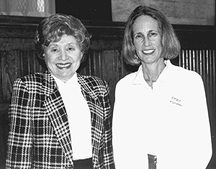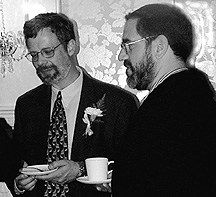|
|
|||
 |
Torch Passers: Hynda Kleinman (right), chief of the Cell Biology Section at NIDCR, on the occasion of her receipt of the annual award for Excellence in Mentoring, conferred by the Bethesda chapter of American Women in Science. Sharing the moment with her is Ruth Kirschstein, NIH deputy director and recipient of the award in 1997. |
 |
Another NIH Feather in NAS Cap: Robert Desimone (left), NIMH scientific director and chief of the Laboratory of Neuropsychology, looking modest at celebration to honor his election into the National Academy of Sciences, as boss Steve Hyman, NIMH director, joins in the congratulations. Also elected to the Academy was John Coffin, head of the NCI FCRDC viral resistance program. |
|
Whoever
receives The NIH Cata lyst in their very own mailbox is
herein advised to look at the mailing address on the back page and
see if it includes an MSC number. If not, please send your MSC number,
along with your name and mailing address, to <wallacea@ors.od.nih.
gov> or fax it to 402-0217. This is the only way to ensure
continued deliverance (of the Catalyst to your mailbox).
A modest proposal put forth by NIH Director Harold Varmus and others would transport the geographically and thematically separated realms of scientific publications into the singular universe of cyberspace, where both strict peer review and a more casual process would speed papers to the eyes of the world at large. Check out the proposal at <http://www.nih.gov/welcome/director/ebiomed/ebiomed.htm>. Some journals have printed
news stories about E-biomed, including Nature (398:
725, April 29, 1999) and Science (284: 718, April
30, 1999). HELP
WANTED: If
shaping a curriculum interests you as much as designing an experiment,
the Foundation for Advanced Education in the Sciences (FAES)
may have a job for you. FAES is seeking a scientist to serve as
director for its courses taught at NIH, a 40-year-old education
program that has an enrollment of more than 2,500 students and offers
nearly 200 courses. The part-time position is being vacated by NIDDK’s
Paul Torrence, who is moving to Northern Arizona University as professor
and chairman of chemistry. The new director must be a scientist
familiar with NIH and its science education needs (but need not
be employed by NIH) who can develop a new curriculum that uses a
modern molecular biology teaching lab. For more info, contact Lois
Kochanski at FAES or call her at 301-496-7975. The time has come for all NIH and FDA staff based at the Bethesda campus to submit poster abstracts for the 1999 NIH Research Festival. Poster applications must be submitted online; the form can be accessed at the Festival web site. The deadline for submission of poster topics is 5:00 p.m., Friday, June 18. Abstract receipt will be acknowledged by e-mail, and applicants will be notified of acceptance by mid-July. The NIH Research Festival is the annual showcase for the NIH intramural program. A Postdoctoral Job Fair, sponsored by the Office of Education, will kick off the Festival on Tuesday, October 5, with plenary sessions and mini-symposia following on October 6 and 7. Poster session themes generally correspond to those of each day’s plenary session and mini-symposia. This year’s plenaries focus on advances in transplantation research, gene therapy, and medical imaging. For further information
about poster registration, contact Paula Cohen at 6-1776 or
e-mail. |
Jim Ellis (OD/ORS/BEPSP) has set up Tom Schneider’s Delila programs to do splice junction analyses for scientists at NIH. Published or unpublished sequence data can be used, but it is most efficient to start with GenBank flat file format. Other change or mutation specifications are acceptable, but the process may be a bit less efficient. The user does not have to learn Delila to use the service or obtain results. A GenBank accession number (or the sequence) and the sequence changes are needed to begin the analysis. Specification on a floppy disk or by e-mail is preferred. See <http://www.lecb.ncifcrf.gov/~toms/spliceanalysis.html> for further information. Ellis
can be found at Building 13, Room 3W-16A; phone: 301-496-4472, fax:
301-496-6608. JSPS
FELLOWSHIPS June 11 is the deadline to apply for a Japan Society for the Promotion of Science (JSPS) fellowship beginning in the year 2000 on either January 1, February 1, or March 1. The fellowship is sponsored by the JSPS, in cooperation with NIH’s Fogarty International Center (FIC) and the NIH Office of Intramural Research. Twenty fellowships are awarded annually; they last up to two years and carry a monthly stipend of 354,000 yen provided by JSPS. Candidates must have a funding commitment from NIH and a tangible (not photocopied) doctoral degree. They must be under 34 years old as of April 1, 1999 (or under 36 if their degree is in medicine, dental science, or veterinary medicine). They must be Japanese citizens or permanent residents of Japan who intend to have research positions at universities or other academic institutions in Japan. Fellowship winners are required to prepare and submit an annual report on their research progress—in Japanese to JSPS and in English to the scientific director and supervisor of their host laboratory at NIH and to FIC. June 11: Deadline for receipt of applications to FIC (in both Japanese and English). July 28: NIH review committee nominates top 30 applicants to JSPS. September 16: JSPS mails out preliminary letters of selection to fellowship awardees and notifies NIH. January 1, February 1, March 1, 2000: Stipends awarded. For application forms,
and further information please contact: Kathleen Michels, JSPS Programs,
Division of International Training and Research, FIC, NIH, Bldg.
31, Room B2C39, Bethesda, MD 20892-2220; 301 496-1653; fax: 301
402-0779; e-mail: <jsps@nih.gov>.
A
technology transfer seminar for scientists—how to interact
with the biotech and pharmaceutical community—will be held
Thursday June 3, from 9:00 a.m. to 4:00 p.m. in Wilson Hall, Building
1. To be covered are the collaborative process, inventions and patentability,
and how scientists can share in the royalty income stream that derives
from their scientific efforts. For more information or reasonable
accommodations, contact Lauren
Neal. |